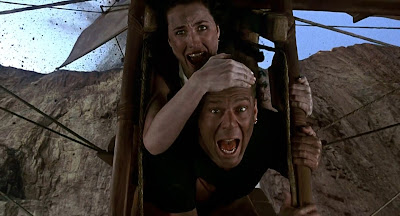 |
| Falling without style: Hawk and Anna make an escape in Leonardo da Vinci's flyer. |
Release Date: May 24, 1991. Running Time: 100 minutes. Screenplay: Steven E. de Souza, Daniel Waters. Producer: Joel Silver. Director: Michael Lehmann.
THE PLOT:
It's the day of his release from prison, and all cat burglar Eddie "Hudson" Hawk (Bruce Willis) wants to do is relax and enjoy a nice, hot cappuccino. But it isn't to be. Small-town mobsters Cesar and Antony Mario demand he rob an auction house and steal a particular artwork: a clay model of a horse created by Leonardo da Vinci.
He and his partner Tommy (Danny Aiello) do the job, but the burglary is only the beginning. Hawk soon finds himself involved with two psychotic billionaires (Richard E. Grant, Sandra Bernhard), a rogue CIA agent (James Coburn), and even the Vatican in a plot to destroy the world economy!
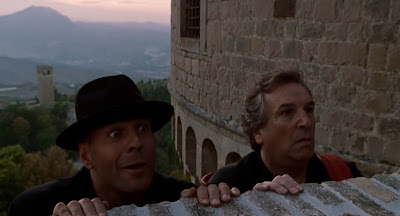 |
| Our unlikely heroes: Hudson Hawk (Bruce Willis) and Tommy Five-Tone (Danny Aiello). |
CHARACTERS:
Hudson Hawk: This was Bruce Willis's pet project, and the only movie in which he received a "story by" credit. Hawk is a lot closer to Willis's Moonlighting character than to John McClane. He's cocky and switches between being smooth in some scenes and almost cartoonishly wacky in others. The character is sometimes incoherent, veering between amazing competence and utter idiocy, but Willis's energetic performance makes him good enough company for the 90-plus minute ride.
Tommy Five-Tone: In the first twenty minutes, Hawk makes a series of cracks about how much weight his partner (Danny Aiello) has put on during his time away. None of these jibes is funny in the least. On top of that, while no one would accuse Aiello of being svelte, he doesn't look any more overweight than the average middle-aged man. Thankfully, the fat jokes stop relatively early on, and Aiello has terrific buddy chemistry with Bruce Willis. Their scenes together are easily the movie's best, which makes it a head-scratcher that the script separates them for roughly half the running time. Also, the film features two musical caper scenes, which reveal that Aiello had a surprisingly decent singing voice.
Anna: Hawk's love interest, an art expert who is working for the Vatican and who hides a secret of her own... one that's as easy to guess as it is spectacularly unconvincing. Andie MacDowell was always a limited actress, and she has no particular screen chemistry with Willis, making her easily the weakest of the movie's principals. Still, she throws herself gamely into a couple of absolutely absurd moments - notably when she channels her inner dolphin during an interrogation.
Darwin and Minerva Mayflower: "I'm the villain!", Richard E. Grant's Darwin Mayflower gleefully tells Hawk in their first real scene together. As the married, psychopathic billionaires, Grant and Sandra Bernhardt go so far over-the-top that I'm pretty sure they achieve orbit. I'd say this is the right approach. The script has them giggling while setting off explosives, then doing a tango after casually shooting two people. Given this, subtlety really isn't called for. Your reaction to these characters is probably going to be a good test of your reaction to the film itself: If you're amused by them, you'll probably go with the rest of the absurdity; if you find them obnoxious and annoying, then you probably won't.
"Kit Kat": Also embracing the absurdity of the movie is co-star David Caruso, in what is certainly the oddest role of his career. He's one of four CIA henchmen, all of whom are named after candy bars. Kit Kat is easily the most interesting of this group. He never speaks. He communicates by handing printed cards to people. Oh, and he loves disguises. At one point, he escorts Andie MacDowell while wearing a dress and wig to match hers. Later, he disguises himself as a Roman statue. Neither of these serve any apparent purpose, and there's never an explanation for them. Frankly, I'd happily watch an entire movie about this character; every time he appears, the results are interesting, and I think Caruso comes the closest to capturing the attitude the film is striving for.
George Kaplan: James Coburn was re-emerging as a screen presence in the early nineties after issues with arthritis had limited his eighties work. The character name, a nod to Cary Grant's role in North by Northwest, is one of the film's cleverer conceits, one that wisely is never commented on in any way. Coburn's talents are hardly taxed, but he seems to savor some of his lines. When Hawk meets him in Rome, Kaplan reminisces about this being the site of his first bare-handed strangulation, then immediately declares that he misses Communism. He also has a fight with Hawk late in the film, with each blow resulting in sound effects straight out of a Bugs Bunny cartoon.
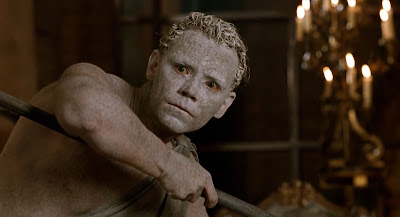 |
| Kit Kat (David Caruso), disguised as a statue. Just because. |
"SAY SOMETHING NICE":
Hudson Hawk may not be a good movie, but I find it an almost compulsively watchable one. Most of the jokes fall flat, but just enough hit the mark. Bruce Willis is at his most engaged, and he and Danny Aiello are terrific on-screen together. The movie maintains a generally amiable tone even when events don't quite seem to flow into each other.
If I were to catalogue all the scenes I enjoyed, this section would go on for several paragraphs, because I found quite a lot to like. Suffice it to say: Hudson Hawk moves fast, and I was amused enough to be carried over the stupidest moments. Among Razzie winners, I'd rate this as one of the most enjoyable.
So of course it was eventually nominated as one of the worst movies of the decade.
A VICTIM OF ITS OWN AD CAMPAIGN:
In part, I think Hudson Hawk was a victim of its own ad campaign. By 1991, the first two Die Hard films had established Bruce Willis as an action star. It was an image that, at that time, he was still kicking against. Just a few years earlier, he had been largely considered a comedy actor, and that's very much the mode he's in here.
There's more Topkapi in this film's DNA than Die Hard - and probably more Bugs Bunny than either of those. Which was not what the studio wanted, so they released it as a Bruce Willis action extravaganza. Something it definitely wasn't. It rarely gets audiences on your side when you advertise one movie and actually release something completely different.
Now, I doubt there was enough of an audience for Hudson Hawk's freewheeling absurdity to make this very expensive film into a hit - but what audience there was for it, largely skipped it; and the audience that showed up for "Bruce Willis, Action Star!" was largely displeased at getting "Bruce Willis, Comedian."
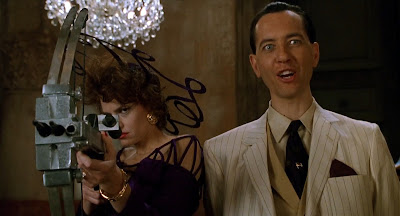 |
| The Mayflowers (Sandra Bernhardt, Richard E. Grant). They're the villains, and they're happy to tell you so. |
OTHER MUSINGS:
By now, it's probably clear that I mostly liked Hudson Hawk, but I'm not going to deny that it has plenty of flaws. The biggest of these is that the movie seems very impressed with itself. It thinks it's a lot cooler, cleverer, and funnier than it ever truly manages to be.
One thing it isn't, though? It isn't boring. The story moves propulsively from one set piece to the next. By the 25-minute mark, we've observed an art heist and a murder. By 40 minutes, there's been an explosion and a car chase with Bruce Willis zipping down the highway on a hospital gurney while being shot at by mobsters. It never stops moving.
Also, while it may be less cool and clever than it thinks it is, there are moments that work. Hawk and Tommy time their heists using songs. No, this doesn't make sense - as Tommy points out, there's a thing called a watch that would be more reliable - but it results in some fun moments. The auction house heist near the beginning of the film is completed in time to Swinging on a Star in a set piece that's brisk and fun. I also reliably laughed every time Richard E. Grant, Sandra Bernhardt, James Coburn, or David Caruso showed up. The actors knew the tone the film was aiming for and hit it dead on... even if Grant became quite vocal in his own disdain for the movie.
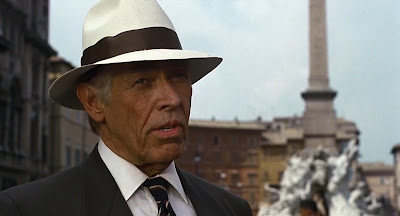 |
| CIA agent George Kaplan (James Coburn) enjoys murder, misses the Cold War, and looks forward to his pension. |
THE OTHER NOMINEES:
Cool as Ice was an attempt by Vanilla Ice to spin his (very, very) short-lived music success into movies. I haven't actually seen the film, but every clip I've viewed is so hilariously awful as to almost qualify as art. Dice Rules is an Andrew Dice Clay standup film. I actually think Dice Clay is a decent actor, as I noted in my review of The Adventures of Ford Fairlane, but it's fair to say that his standup persona is not at all to my tastes, and I will continue to avoid Dice Rules.
I have seen Nothing but Trouble... unfortunately. Dan Aykroyd's lugubrious stab at feature film directing wastes the talents of himself, Chevy Chase, Demi Moore, and John Candy. Hudson Hawk may be a lot less funny than it thinks it is, but Nothing but Trouble is never funny. It's also visually ugly and leadenly paced. Finally, there's Return to the Blue Lagoon; other than featuring an early performance by a young Milla Jovovich (given the nudity, I'd argue too young), I doubt there's anything interesting to say about it.
Either Cool as Ice or Nothing but Trouble seem considerably more deserving of a "Worst Picture" title than Hudson Hawk. It's common enough that I disagree with the Razzies' final decision. It's far less common that I come out thinking that the "winner" was probably by far the best of the films nominated!
OVERALL:
Hudson Hawk is always on the verge of going off the rails throughout, and it finally does so near the end. The last twenty minutes falls almost completely flat, and the resolution is both rushed and predictable.
Still, for 80 of its 100 minutes, the movie had me. I knew it wasn't good, but it kept a smile on my face and kept me entertained. Given the nature of this review series, it's unreasonable to expect much better than that.
Rating: Popcorn & Soda.
Worst Picture - 1990: Ghosts Can't Do It
Worst Picture - 1990: The Adventures of Ford Fairlane
Worst Picture - 1992: Shining Through
Review Index
To receive new review updates, follow me:
On BlueSky:
On Threads:


No comments:
Post a Comment